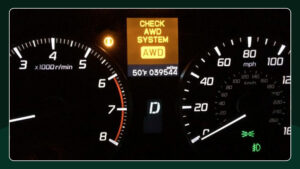
Is the “Check AWD System” indicator light on? (What it means and common causes)
An all-wheel drive (AWD) system transfers power to all four wheels. Four-wheel drive is found on many modern vehicles, especially in areas where severe winter weather is common. If there’s a problem with your four-wheel drive system, you may see a message that says “Check AWD System” or something similar.
Not sure where to start? We’ll explain what this warning means, why it appears, and what to do if you see this message. If you see the message “Check AWD System” on your instrument cluster, it indicates a problem with your vehicle’s all-wheel drive system, whether it’s a Toyota Highlander, RAV4, or Lexus RX350.
This is most common on Toyota and Lexus models, but other automakers use similar messages to indicate four-wheel drive issues. You might see the message “R.DIFF TEMP,” an engine check light, “Check AWD System,” or simply “AWD.”
Causes of Four-Wheel Drive System Trouble
1) Overheating Differential
An overheating differential is a relatively common trigger for a four-wheel drive system warning. Driving a car with ill-fitting tires or driving hard for long periods of time can cause the differential to overheat. Hot weather and extreme driving conditions increase the chance of the differential overheating.
2) Low or old transmission or differential fluid level
If your differential fluid is old, low in quantity, or the wrong type, it will not properly lubricate the differential or transmission parts. This can result in increased wear, slipping, rubbing, rattling, and other unusual driving sensations.
If you have recently changed your transmission or differential fluid and are noticing these problems, check to see if you changed the fluid to the correct specification. Your user manual should include a list of specifications that must be met for each type of fluid.
3) Tire Mismatch (Tread Wear)
AWD systems tend to be more sensitive to differences in tire diameter. This is because many four-wheel drive systems are equipped with one or more locking differentials. These locking differentials generate heat because they limit the rotation of the wheels. Excessive heat can cause the differentials to wear out prematurely.
If the wheels rotate at different speeds for a long period of time, as would be the case if the tires were not all the same diameter, the differential lock must work harder. If one or more tires do not match, you can find a tire shop that will grind the tires so that the tread depth of all four tires matches.
To avoid this situation, always remember to rotate your tires. While tire rotations are relatively inexpensive, neglecting the maintenance can be costly if you are replacing any part of your four-wheel drive system.
4) Transmission Issues
The transmission is a critical part of the drivetrain that transfers power to each differential in your four-wheel drive system. Many front and center differentials are integrated into the transmission housing. Depending on the manufacturer, this is often referred to as the transaxle.
Transmission problems can cause a variety of issues with your four-wheel drive system, including difficulty shifting, transmission slippage, and wear. Unfortunately, many transmission problems require costly repairs.
5) Traction control or stability control system issues
Not all AWD systems work the same. Some vehicles rely heavily on their traction or stability control systems to limit wheelspin. If there are issues with the traction or stability control system, you may also see an AWD warning on the dashboard.
Traction control and stability control systems are mostly electronic, but they make heavy use of wheel speed sensors (also known as ABS sensors). Make sure the wheel speed sensors are working properly. You can check the wheel speeds with a quality diagnostic tool.
6) Open Sensor, Wiring Problems, Faulty Ground
The cause of a four-wheel drive problem can be as simple as a broken sensor or wiring problem. Modern four-wheel drive systems use sophisticated electronics and software to monitor and control the four-wheel drive. Some four-wheel drive systems use the brakes to control wheel slip, which is cheaper and easier to implement than a limited slip differential.
A broken sensor, a wire with worn insulation, or a faulty ground can cause a four-wheel drive warning when the ECU detects an incorrect input. Wiring issues can be a big problem, but if you have the factory service manual, it’s pretty easy to find a disconnected sensor.
7) Electric Motor or Hybrid Battery Issues
Some hybrid vehicles use a gasoline engine on one axle and an electric motor on the other. Electric vehicles can have dual motors; one motor for each axle of the vehicle. If there’s a problem with the electric motor or hybrid battery, one or more axles may not have power.
If there is a problem with the hybrid battery or electric motor, you will receive an additional warning on the dashboard indicating this issue. Hybrid batteries can fail over time, but they are replaceable. Unfortunately, the cost of replacing a hybrid battery can be very expensive.
Frequently Asked Questions
What should I do if the four-wheel drive warning light comes on?If the four-wheel drive warning light comes on, it is important to have your vehicle inspected as soon as possible. As mentioned above, the warning light can indicate a variety of issues, some more serious than others.
Otherwise, make an appointment with your local dealer or a good independent mechanic that specializes in your vehicle brand.
Can I still drive my car if the “Check AWD System” light is on? Continuing to drive your vehicle when your AWD light is on can cause further damage to your vehicle and put you and your passengers at risk.
How often should I have my AWD system inspected?
We recommend that you have your AWD system inspected at least once a year or as recommended by your vehicle manufacturer. Regular maintenance and inspections can help prevent problems with your AWD system and ensure it is functioning properly.

